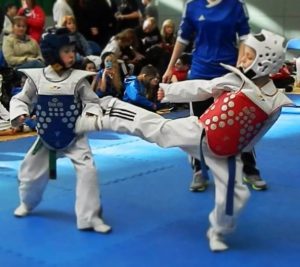The roots of Taekwondo can be traced back over thousands of years, however its name did not come into use until the 1950s. ‘Taekwondo’ translates as ‘The Way of the Foot and the Fist’ and it can be broken down into three main aspects: Traditional Technique, Self Defence and Sparring.
Traditional Technique is where the ‘art’ in martial art becomes apparent. Students learn the formal way of performing blocks, kicks and strikes, and Patterns (also known as Taegeuks or Poomsae) are a major feature of this part of Taekwondo. Self Defence utilises all the moves you have learned in traditional, but in a practical and fluid way. Finally, there is sparring. Taekwondo became an Olympic sport at the Seoul Olympics in 1988 and this aspect is almost entirely footwork and kicking. As a student progresses through the belt colours (white, yellow, green, blue, red, black), he or she is gradually introduced to more complex syllabus, at a pace suitable to them. All classes (apart from the Elite Team classes which are entirely sparring) cover a mix of each aspect of Taekwondo to ensure the student gains a rounded knowledge of the martial art.

To understand Taekwondo we must also understand the martial history of its home Korea.
Situated in the northeast corner of Asia, between the two giants of Japan and China, Korea has traded, fought and shared with its neighbours.
The first traces of Korean society and fighting styles can be traced back 5000 years. Various forms of wrestling and grappling existed – used as much for leisure as for defence – in the various provinces of the country.
As Korean society developed so did the fighting styles. During the Koguryo Dynasty (37BC to 668AD) swordmanship, spear fighting and archery, as well as wrestling, were prevalent within the population. Some scholars believe it is at this point in history that the first style of unarmed combat can be found. Subak concentrated on mainly hand techniques with little use of the legs. Styles of unarmed combat continued to evolve with Taekyon emphasising the use of advanced kicking techniques.
In the Sillia Kingdom (57BC to 667AD), the first evidence of the Hwarang was found. For many martial artists the Hwarang represents the first true martial art movement in Korea. That is, they were known for code of conduct, developed through their educated and enlightened attitude, as they were for the martial skills. Modern Taekwondoists do not use swords or the bow or even the same forms but they believe that the Hwarang embody the theological heritage of the art.
From the time of the Hwarang to the Japanese occupation, traditional arts continued to grow and develop. However, with the Japanese occupation, the practice of all indigenous martial arts was banned – replaced by the Japanese arts. As the invading Manchurian tribes of hundreds of years previous had left their mark on Korean culture so had the Japanese occupation.
With the end of Japan’s occupation the Korean government encouraged the practice of the arts to celebrate Korean culture. The 1950s saw a leading group of Korean grandmasters, each representing a Kwon (school), come together to unify under one name and one style. In 1954 they agreed on the name of Taekwondo chiefly because of the similarity in name to Taekyon.
The development of Taekwondo since then has been unparalleled. It is the most widely practiced martial art in the world and modern day Olympic sport.
